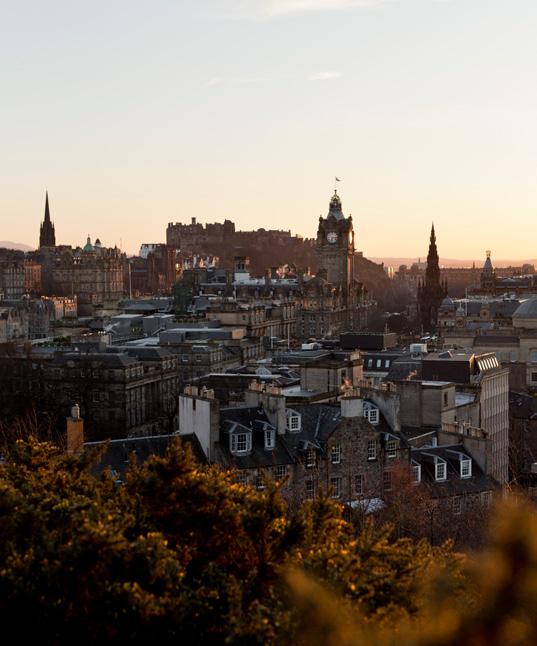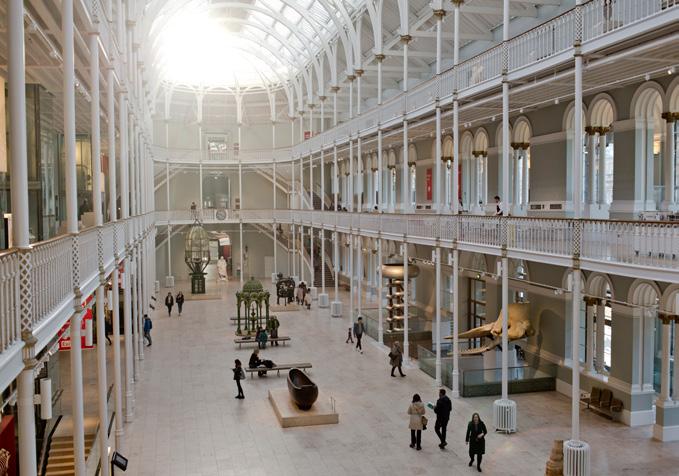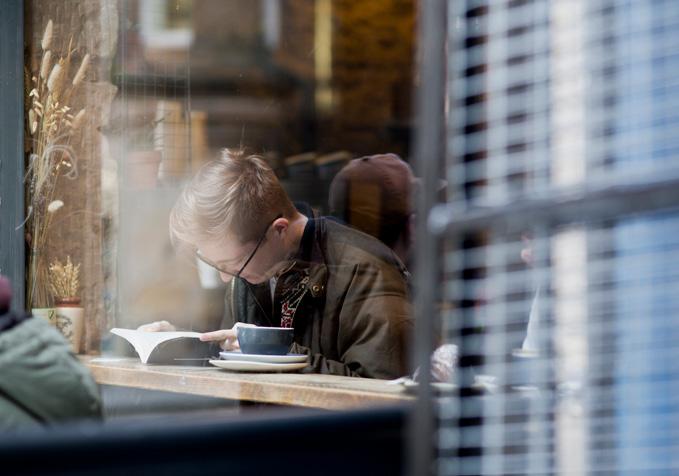
15 minute read
Imagine Change
A Conversation Between Peter Millican Obe And Poet Janette Ayachi
J: So, Peter, you have this pioneering sensibility to amalgamate commerce with the arts in the complexes that you envision, how did that become so important to you, what inspired you, or has it always been part of the masterplan? Or was there something that prompted you to start commissioning artists within your commercial development projects?
Advertisement
P: I’ve always been interested in the arts and I like music very much. I learned to play the viola with my daughter a long time ago, I don’t play it very much anymore, but I love music. In Central Square, our first office building in Newcastle, we used to have chamber music concerts in the atrium, people could come in and have lunch and just enjoy, the arts add to life and form an important part of it. I’ve always felt that when you’re creating buildings, it’s like a sculpture which people live in which is very exciting, you’re creating something artistic which is going to be there for a very long time, creating a place where people interact with other people to form memorable experiences.
In Newcastle we started in a small way with both music and sculpture, including commissioning ‘Vulcan’ from Sir Eduardo Paolozzi. After that I went to London to build Kings Place, a much larger building which was able to support more arts. In London, buildings were getting bigger and bigger and excluding the population from large parts of the city and I wanted to create something which invited people in, so it worked as an office space but also gives something back to the community. Kings Place has grand public spaces with many paintings and sculptures, and the concert halls which I still run, make a significant contribution to London’s musical life. If you’re an office tenant, it makes the office a much more interesting place to be.
We see a very wide cross-section of people in the atrium, from mothers and babies in the mornings, journalists, artists and musicians are there all day, and many people go to London on the train for a quick meeting and arrange to meet in Kings Place. We also have the “Last of the Summer Wine” group who buy a bottle of wine and reminisce, we see children doing their homework, we often have ten or twelve teenagers who come in and spread themselves out to do their homework together. We have an adult group that come in to speak French together and of course we have the concert goers on their way to hear jazz, folk or classical music downstairs in the auditorium. It’s interesting that art can create value as well as being valuable in itself. Art makes an office a more attractive place to spend time in, the tenants tend to stay for longer as their employees enjoy working there so your income is more secure, so in terms of a business strategy it’s not a crackers idea either! Whilst all businesses need to make profits to grow and prosper, I’m in this because I want to do something worthwhile and something interesting.
Now, I am tremendously excited about Edinburgh Park, which will form a new urban district. It’s an astonishing intellectual challenge and responsibility to create something that people will want to be part of for the next hundred years, which will form a new hub for West Edinburgh. Things will form around it, it will be very influential and I feel that people will come to see it as an example of what can be done.
J: I completely agree. Especially with all of the traffic that leads from the city centre. As a retail entrepreneur and an arts philanthropist, you have erected office buildings in Newcastle, created properties at London’s King’s Cross, strategised whole civic squares, conference facilities, all alongside specially enlisted works of art. You have created residencies and curated programmes, and in a prophetic manner you seem to give people exactly what they want, an all-inclusive, progressive place of work and play, which may become the model for others. What do you like about Edinburgh, and how does it compare with working in Newcastle and London?
P: I like the architecture, I like that you can walk everywhere, I like the fact it has good restaurants, that it has culture, I like the fact that it’s near the mountains, that it’s by the sea!
J: You’re singing our praises now!
P: I think it’s a great city. It’s a capital city, it’s a city to live in, to work in, and to visit.
J: Where do you live?
P: We live about 20 miles west of Newcastle in the Tyne valley in the country.
J: Sounds idyllic!
P: In this crisis, the first three or four months were amazing; we walked every day, we cycled, we watched the spring plants come out, the bulbs come out, the magnolias come out, we experienced nature in a way I’ve never done before because we were there for the day by day changing. The weather was also amazing, so it’s been an appalling time but that was a silver lining for us.
J: It’s been a great time to connect with nature. Let’s talk about the partarchitectural, part-sculptural, tumbling crab-pink shipping containers turned gallery space and building – which to me looks like a set of coffins in a sepulchre, a design envied by even the Ancient Egyptians – it shows us how we can shape shelter from the stuff that is thrown away; reusing resources, reclaiming what has been lost in the expanse, I think it’s such a gorgeous piece of architecture, what has it been like working with David Mach on his first building?
P: David is very exciting to work with. When we started off, we knew we wanted a building to do the sorts of things you’ve described, and we thought it would be fun to do it with containers of some sort. We had a very pedestrian idea of what we might
“David Mach bought a quantity of Bacofoil packets, cut them up and made them into a model! We were just blown away by it, it was just astonishing. The model was pretty close to what we’re actually going to build.” create and we thought it would be great to have an artist involved, so we approached David and had no idea what he would come back with. He bought a quantity of Bacofoil packets, cut them up and made them into a model! We were just blown away by it, it was just astonishing. The model was pretty close to what we’re actually going to build.

J: So he had the vision and was able to make it on a microscale, I think that’s great!
P: David had the artistic concept and then our team put together the practicalities of it. It’s a very complicated building to build, to make watertight, we want it to last a long time so the practicalities of it took a lot of work but we have now hammered all of that out and it feels like we’ve cracked most of the issues.
J: Construction and building energy-use usually account for a lot of energyrelated carbon-dioxide emissions (the operational carbon emissions and the embodied carbon of a building) so that this entire endeavour is capable of operating a net-zero carbon footprint is something quite incredible, and with the sense of urgency centred around climate change right now, it sets a standard role model for future building.
By using recycled materials, we are paying homage to our ancestors and respecting the ambitious drives of our children. How important is an ecofriendly strategy to you and how easy is it to operate carbon neutral?

P: I think carbon neutral construction is nigh on impossible. It’s very difficult, you can do offsetting, you can plant trees to offset it, but apart from offsetting, it’s almost impossible. Zero carbon operation is absolutely possible however, and that’s what we will be doing. You want to reduce the embodied carbon as much as you can however, and we’ve done a number of things to help that, but the really big achievement is to make the operation zero carbon.
I think it’s important for all sorts of reasons, it’s important for the planet, clearly climate change is happening and we have to do something about it and it’s within our power to do something about it. In my first office building, 25 years ago we put in a system that used only sixty percent of the electricity that most office buildings use and I’ve kept that ethos. At the time nobody was interested in issues like that, they just weren’t, but now I think individuals care and that’s making the corporations care. It’s important for corporations to say in their accounts that they’re thinking about the environment, so to offer them a building which is zero carbon in operation is a big thing for them.
J: It’s huge and spectacular. You were talking earlier about Eduardo Paolozzi’s ‘Vulcan’, one of the series from his Vulcans, and you were saying that it was in Newcastle before it was moved to Edinburgh Park?
P: It was originally commissioned to be in Central Square in Newcastle. We met Eduardo and asked him to create a piece for us 25 years ago. Since then we’ve had a number of different sculptures on that site and ‘Vulcan’ has been to several locations. When we met Eduardo in London, and said we’d like him to make a piece for us, he showed us various maquettes that he had, we chose the piece, chose the foundry that was going to make it and the rest is history.
J: ‘Vulcan’ fits in so well with the assemblage of work that you’ve created because, not only does it speak to the future, it also embodied this aesthetic of myth, of the past. You manage to create a modern aesthetic that also speaks about the history.
P: I hadn’t thought of that, it’s interesting. I do think it’s one of
Paolozzi’s best pieces. At the moment it’s in the Yorkshire Sculpture Park on loan, I was there the other day and it’s just such a dramatic piece when you stand next to it, it’s astonishing.
J: Not only do the commissions speak of both past and future, they also move away from the monolithic utter sameness that we often see spread globally; Edinburgh Park has also created a rare visual aesthetic within the urban space. Do you like to subvert the viewer by offering a programme of art, architecture and artefacts that both blend in and show-off and stick out in the environment - something at once fabulous and striking, yet it still restores our relationship to the natural world and reflects our culture?
P: I’m not a curator. All of the works that I’ve chosen, I like. There’s a wide range of sculptors who we have pieces coming from; as well as the big pieces, there’s also quite a few small pieces which will be in the buildings and we will create an art trail so people will be able to walk around with a guide to all of the pieces that are there. We also plan to have changeable pieces, we will have the pieces that are part of the main collection, but there will also be rotating works as well. It’s about creating a place for the people who are there but also we aim to attract people to come and have a look, to walk through the park and enjoy it.
J: I like that some pieces will change, that it’s not concrete and as society shifts its perspectives, you can accommodate that. I’m noticing the amount of freedom that you allow artists the trust to take sculptural risks or work with their intuition so what we end up with, is a landscape entirely maximised by a relaxed state of being. Visitors and residents will feel this too; they will dip into the dreamlike development park that is both beautifully restrained, minimalist and modernist yet simultaneously ancient or archaic, almost as if it embraces the binaries of time and duality of essence; these are qualities that make a location deep, layered, and idiosyncratic. The art here at Edinburgh Park is not only tied to place and culture but also to the passion of the artist responding to the scene. Was this your intention?
P: It’s a mix, sometimes we’ve chosen works that are already made and other times we’ve asked for a piece to be made specially. With David, that was completely what happened: we asked him to make a piece. So, there is a mix which seems to work quite well. Another thing that I’m really keen to do is to get children involved in coming to look at the art. With ‘Vulcan’, we constantly had groups of children sitting around drawing it, from small children up to art school students, there were always people drawing it and I think that is wonderful. Matthew Jarratt will help a lot with making that programme work and engaging with young people.
J: I was particularly moved by one of your earlier projects; the spiritual stumble over a five-hundred-year-old Bavarian forest oak tree that was used in the construction of your concert halls in London. I imagine the moonshine adding to its natural polish, the veneer shivering above a rustling practising quartet. There is poetry in the surroundings, in the anatomy of the building and the way it holds and accentuates the acoustics of music; of sound and story. Is there one stand-out detail in one of your projects that inspired you along the way?
P: You’re right about the tree, it’s true. We went to Bavaria to see a veneer specialist near the forest, they had a range, and said that the concert hall was a special project and they had a very special tree called Contessa – very Mozart. They said we had to take the whole tree, we couldn’t just take bits of it, the tree was cut down under the light of the full moon, they let it lie for two weeks for the sap to drain then they boiled it in a water bath of 80 degrees then they slice it 0.6mm thin. Out of Contessa we took home an acre of veneer! Every surface in the hall, other than the floor, is made out of that one tree and you can still smell it when you walk in, it’s lovely.
J: I think that would bring such a deeper element to an environment that will speak to people, especially at the moment when we’ve become so desensitised, we need deeper connection.
P: Dovecot are weaving a tapestry for us which is based on an original Rubens painting, which is in the National Gallery. Leon Kossoff did many drawings based on major paintings that are in the National Gallery in London, and he made one which was based on a Rubens painting, ‘Minerva protects Pax from Mars’, which was given to Charles I as an anti-war offering from the Spanish Crown. Kossoff did a semi-abstract version of the painting and the studio are weaving a tapestry inspired by Kossoff’s painting. The tapestry will be four meters by three meters and it will hang in the reception of our first office building. It’s a wonderful statement.
Thinking about the oak tree, I wondered what was particular about Edinburgh Park and I think the tapestry is it; it’s Dovecot, it’s Edinburgh, and it’s a very strong statement. It will be a very fine work when it’s finished. They are now weaving it, you can actually go and have a look at it being woven, three people will work on it for a year to weave it.
J: The best things are worth the wait! Can you tell us a bit about the Big Noise Youth Orchestra?
P: The Big Noise Youth Orchestra takes young people, teaches them to play music, gives them intensive tuition which children don’t get in schools anymore and they change children’s lives. I believe that music and sport can change people’s lives in terms of physically taking people out of where they are. The Big Noise work in very deprived districts, they’re working on getting some support from Edinburgh Council and once they get that, we’ve said that we would support them for the next five years in some way.
J: The spring of 2020 is suggestive of how much, and how suddenly, we can change as a civilization. I believe that you are the first in Scotland to mix commercial space and arts like this in an unrivalled setting within the public realm, to give life to a spacious, contemporary new quarter of the city, that is geared towards the community and will have a wonderful way of reuniting us as a people again after all the sanctions on the collective, more than ever, the individual wants to work or sleep or play in a new-build district that has a strong sense of inclusivity and society around them. It is a tough time for office spaces and developments as the economy slips through a series of dislocations, so, absolute kudos for pushing through and still persevering with this plan – do you think quality wins through in the end? (You know. You can’t stop the waves, but you can learn to surf!)
P: I think you need a generosity of spirit and it usually works out okay. I’m not saying that in some instances you couldn’t make more money by not doing things that are worthwhile… We don’t want to lose money, we’d like to make some money, but it’s about more than money.
J: I’ve lived in Edinburgh for over a decade and I’m excited about this, I don’t think it’s been done before, I think it’s what we need, especially right now as the new world is emerging. When they opened up the brewery outside Edinburgh Park, I remember thinking about how getting on a tram felt outside of the city, but once I was there I was amazed by how much was outside of the confined space of the city centre that we’ve limited ourselves to.
P: Edinburgh has a grand history of culture and I’m happy to be a part of that in a small way.
J: They say the eye of the beholder is the collector – Are you always happy with the final symphony when your developments open their curtains, does everything usually go to plan as curated?
P: Things constantly change. Very often, it’s an iterative process; you put something down and then you see something, and then you see something else and then you modify. It’s a long process of developing and maturing the plans.
J: What inspired you to choose the name Parabola?
P: I like the shape of the curve
J: I think the meaning of Parabola reflects the way you select works that you want so showcase.
P: That’s very interesting that you would see it like that. I think there’s some truth in that!
J: I think with any construction in a place there needs to be a deconstruction of the environment’s history, it’s important to uncover and resurface stories, to excavate the meanings behind street names, to unearth figures lost to obscurity, and to rediscover various styles and interpretations. This way, we can reconstruct and repair the present. The art is embodied in the landscape and the landscape then embodies the people. The issues we face are global, as our current pandemic has reminded us, specific local character and innovative impact will inspire on the other side of the world –will developments like this become fashionable do you think, catch a trend?
P: One would hope that it would influence people as we’re influenced by the places we visit. Certainly, Kings Place has changed what it means to be a city building and a lot of people have been to look at it for inspiration. I think that you want to stand on the shoulders of giants and learn from them!
J: And how do you think art reflects that especially when so much of it is open to definition, review and reverie? If symbols are fluid, and not fixed, their meanings alter from one time period to the next do you think that as time shifts we deviate more and more away from the plan, the original intended message, that somehow separate societies depict things differently and that something that was once intended to be devotional can now become offensive or insulting for example? Or does this just add to the metamorphic qualities of a piece of art, or a poem, or a building? Do you think it is fair to say that art only represents what the viewer imagines and then verifies in a reflection of the time, that we need not worry too much about projections at all, but more on the very natural core humanism involved here, that art makes us feel things; it improves our brain functions and thinking patterns, our entire physical wellbeing is given a boost – everywhere, every era, someone gets some of this good medicine?
P: People spend three years at university studying that question! I’m not sure how I can answer concisely but art is different in different generations, and a lot of it reappears and is used again and reinterpreted. It’s like the tapestry; the original Reubens painting was made into a work by Kossoff and it’s now being made into a tapestry. These things do sort of waterfall down, really good works do. Hopefully, in a small way, we will have an influence.







